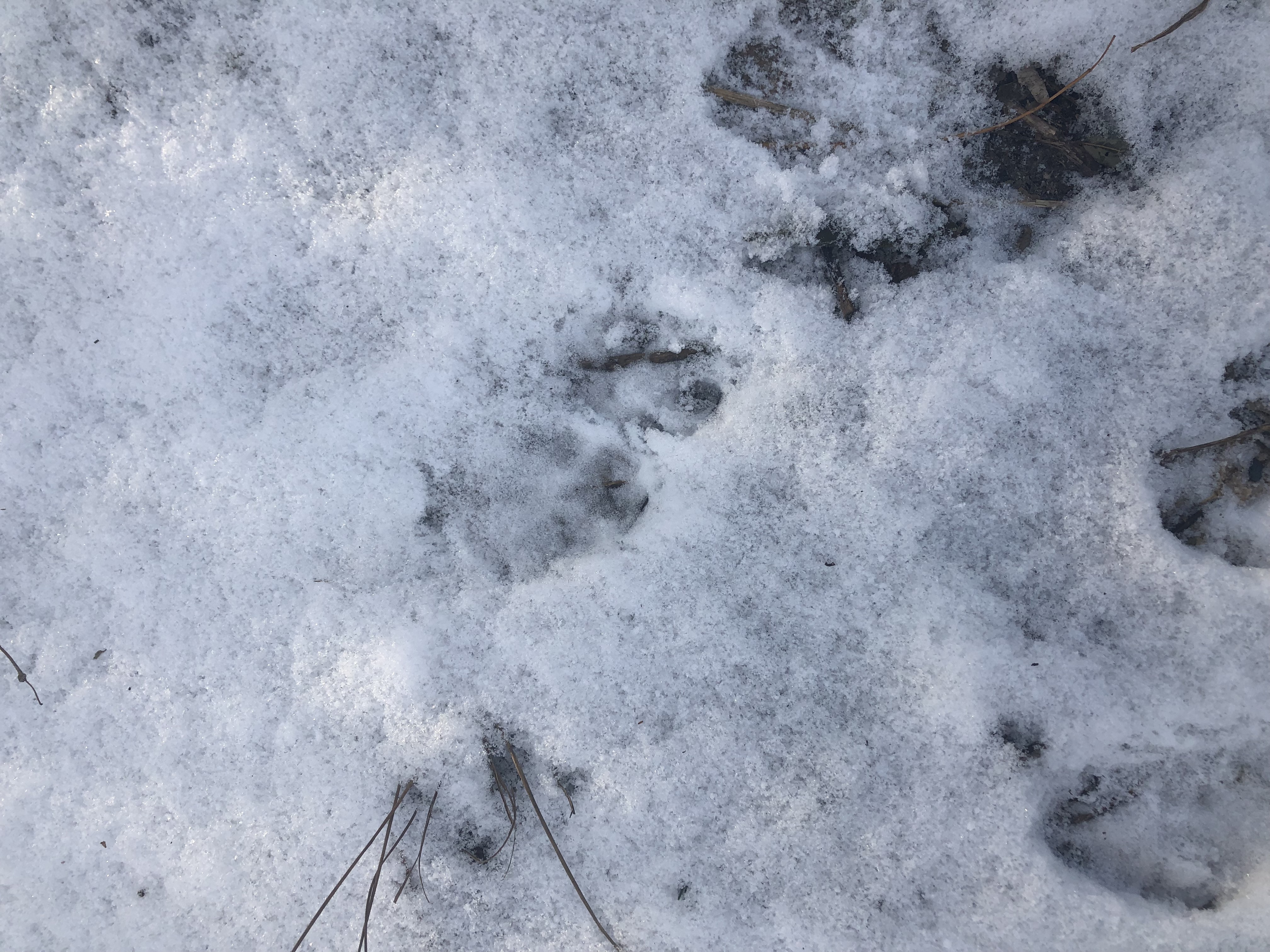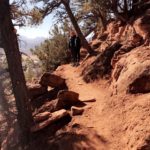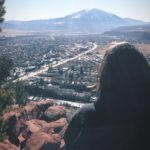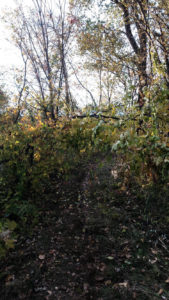It has been a while since I last visited my site down by the water, but yesterday was magical. With a light snow cover, the woods were more beautiful than before, and the presence of a sunny day only helped that. As I walked my path, I kept in mind the words of Walt, “Be on the lookout for tracks,” and to my pleasant surprise, there were many! Though some may have been attributed to small dogs, there were smaller tracks that looked like they could have been a rabbit running around, keeping warm in these frigid months. I heard the wind, and the sun glistened off the leafless trees- the Ash looking especially bedazzled. It is always so amazing to me how I am able to hear everything and nothing while I walk that path. The sounds of the water lapping- more angrily as it fights off the cold- and the crunch of the snow is so loud, yet so peaceful in a world of sirens and development. I will be sad to leave my little walk by the water for a while, but I wish it, and all its creatures, a Merry Christmas, and a Happy New Year in my absence.
https://www.google.com/maps/d/edit?mid=1pgWw9B54JUnHP2_GpTIf4ZizNoaGcfw0&ll=39.41919408464963%2C-107.22065929999997&z=18
I have marked the location of my Phenology site back in Colorado to ensure that if any of you wanted to visit and experience the wonder for yourselves, you would have that chance!
Posted in Uncategorized | Leave a Comment »
In my last post to you all, I alluded to a place with red soil, and dry air. This trail has held a special place in my heart since I was small, and was just as special when I hiked it this past week. Mushroom Rock is the epitome of Western Colorado landscape with it Pinyon, Blue Spruce, and native Sage. The trail is mostly shaped by rock, colored Red by the Iron Oxide found in the soil. It is incredibly steep, but at the top, there is not only the Mushroom Rock but a view of Mount Sopris and the entire town of Carbondale. When I am up there, it feels like the entire valley opens up and I can actually breathe again. That being said, after being at sea level for three months, my heart and lungs might disagree. 8,000 feet is no joke.
The Red Hill the trail cuts through was formed in the build-up of pressure of the North American continental plate that formed the Rocky Mountain chain. Another factor though, that has contributed to the amount of iron in the soils is the presence of two currently dormant volcanoes in the area. When volcanic eruptions occur, they release many minerals into the soil and atmosphere that can be rich in Iron. This, combined with the high elevation and lack of precipitation, facilitates the vegetation and soil health in the area.
The Red Hill trail system has been home to me in times of joy, and times of crisis, but no matter the need or reason, it has been home to me my whole life. Being up there with my mother and sister and watching the young couples mountain biking, dogs running ahead of their owners, and my own sneakers becoming more and more coated in red dust. It made my heart whole, and just in time for Thanksgiving thoughts.
As I hiked, I thought of the differences between my current landscape and my phenology site back in Burlington. The largest and the most obvious difference would be the presence of water, whether it be bodies of water or actual precipitation. My phenology place in Vermont has been shaped by the several saltwater bodies in Lake Champlain history and that can be seen in the presence of sand lining the trail. Further, contrasting with the aforementioned erroneous soils of the Western Slope, the salt water oceanic history has left more Calcium rich soils in the lower Burlington area. There is a much higher level of vegetation stemming directly from the astronomical increase in precipitation. The presence of an understory is representative of the fact that there is more water which allows for more flora to grow and prosper without outcompeting for resources other than shade. In such a dry climate, the lack of water is the main limiting resource in the Red Hill area, that most vegetation grows to be the same lesser height.
Western Colorado has also been much less of an industrial hub than Burlington in its history. The main purpose of the area surrounding Mushroom Rock was housing for old mining towns higher in the mountains, and development for the Homestead Act citizens. There was cattle ranching, just as there is in the Burlington area, but because my phenology site is so much closer to the Waterfront where most of the logging and industrial shipping took place, the effects of the land use in that specific spot varied. Because of this, and because the deforestation that resulted from and caused the industrialization of the Burlington waterfront, there is much more of a presence of newer growth trees and vegetation than there is in the dry Pinyon and Spruce forests found in the Red Hill area.
I hope all you readers out there were able to get some true R&R this Thanksgiving week. Happy times!
Posted in Uncategorized | Leave a Comment »

When I was walking down to my site, I tried to turn into the trail that walks through the woods, when I was approached by a large golden retriever who seemed more than excited about the changing seasons, just as I am. Because most migration has already taken place, the woods were almost silent as I walked through, with only the sounds of the lake water lapping up against the shoreline, and the sounds of the leafless trees swaying in the wind. I noticed that the ground was stacked with fallen leaves of all colors- a change since I had last walked through. It wasn’t until I heard the sound of a squirrel sitting on a branch, that I remembered not all life had left these woods behind. In just two short weeks, the busy, colorful woods by the waterfront where my site lies is now quiet, but for the few leaves still slowly falling, and the distant sounds of a squirrel scurrying about. It made me think about the silence that winter brings and the length at for which that silence lasts.
Posted in Uncategorized | Leave a Comment »
Down by the waterfront,
I feel the leaves red, orange, yellow, green, brown,
Colors I have only seen from far away.
The yellow of trees back home
mixed with red as cherries fresh from the front yard tree
planted by the hands of my sister, my mother, my father, myself.
This place reminds me of home.
How funny it is, that each time I visit down by the waterfront,
the sunshine welcomes me, just as I welcome it from its slumber behind the clouds.
She says hello, and invites me to walk further into the trees.
She tells me to hear the rustling of her wind, the lapping of her lake,
the chirps of her squirrels.
She pokes her rays in as if to hug me like the mother I miss;
a different kind of mother.
Down by the waterfront I am confronted with the wish for going back, while the fallen leaves under my shoes remind me, there is only moving forward.
Posted in Uncategorized | Leave a Comment »
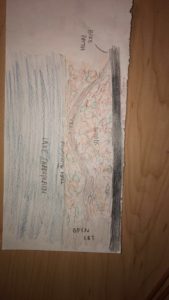
Walking through my phenology site, I was able to see that most of the colors of the leaves had turned to either red or brown, whereas they were still very green. The sun was shining through the leaves, and there were very few birds or animals. I was able to see a few squirrels climbing the Oaks in the area. It made me feel so calm being in the woods during golden hour with the world around me looking just as golden.
Posted in Uncategorized | Leave a Comment »
On my last night with my mom before starting here at UVM, where I seem to have now wound up as a blogger(…?), I discovered this spot off the Island Line Trail near the waterfront, and absolutely loved it. I can’t wait to discover more for myself, and for whoever finds themselves reading this about this area and the ecology that makes it work and live.
Posted in Uncategorized | 1 Comment »
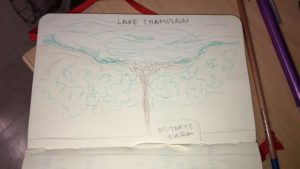
To get down to my place, I took the bus down to the water front and then walked on the bike path towards North Beach until I reached the Fitness park, where there is a trail leading down to the water. When I was walking around and looking at all the trees, I had to really try to identify some of them with more than just my own knowledge. I was able to see many and mostly Eastern Cottonwoods, which are typical around bodies of water, American Elm, several Silver Maples, and many small ferns in the underbrush.
Posted in Uncategorized | Leave a Comment »

